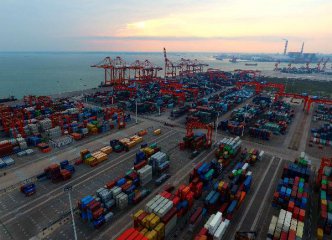
China's economic growth held steady in the first five months as key service indicators rose rapidly, suggesting that structural upgrades have cushioned long-term downward pressures.
"Led by supply-side structural reform and innovation-driven strategy, the national economy continued to grow steadily in May with increasing coordination of development," said Liu Aihua, spokeswoman of the National Bureau of Statistics (NBS) Wednesday.
The NBS reported May growth of 8.1 percent for the service sector on Wednesday, flat with April and extending the rally since the beginning of the year.
The data confirmed the message that the ongoing growth model transitioning was providing new impetus to the world's second largest economy.
The service sector accounted for more than half of the Chinese economy last year. NBS data shows that the service sector has taken up a bigger share of GDP compared to the secondary industry in 60 percent of provincial-level regions.
One of the latest provinces to join the trend was Shandong in eastern China. In the first quarter, the proportion of local service sector contribution to GDP rose 1.5 percentage points to 51.1 percent, according to the provincial government. Seven of the top ten provinces with highest GDP have seen such shifts.
"The shifts show Chinese economy is becoming dominated by the service sector. Under downward pressures, industrial upgrades are vital for sustaining economic growth and avoiding the middle-income trap," said Chi Fulin, head of the China Institute for Reform and Development.
More profound changes are happening in relatively developed regions. In the eastern metropolitan of Shanghai, the proportion of the service sector contributing to GDP reached 50.8 percent in 2004. Local investment growth rate eased to 6.5 percent in 2014, lower than the 7 percent regional growth. The city's GDP grew 6.8 percent last year, exceeding the national growth rate for the first time in eight years, with the service sector contributing over 70 percent.
"The change is a milestone in Chinese economy. It showed Shanghai got over the investment-driven growth model which China has relied on for years," said Li Yang, director of National Institution for Finance and Development, under the Chinese Academy of Social Sciences (CASS).
Compared to developed countries such as the United States, however, the service sector's contribution to GDP in China remains low. But the sector has huge growth potential as it becomes increasingly attractive to investments.
Wednesday's data showed that investment in the service industry jumped 11.6 percent year on year in the first five months, 3 percentage points higher than overall investment growth. Investment in the service sector rose 10.9 percent year-on-year in 2016, outpacing a 3.5 percent increase in secondary industries, according to official data.
A CASS research report forecast the service sector will account for 72 percent of China's total industrial output and provide 56 percent of the country's job vacancies in 2030.
Other highly-watched economic figures released Wednesday, including retail sales, fixed-asset investment and housing sales, also supported firming of the economy.
Boosted by strong online sales, retail sales grew 10.7 percent year on year in May, signaling continued consumption strength.
Growth of the property development investment slowed for the first time since November as the market showed signs of cooling after the government's increasingly stringent cooling measures to quash potential asset bubbles.
The International Monetary Fund Wednesday raised its forecast for China's economic growth this year to 6.7 percent. The forecast was an increase from its already-raised April forecast of 6.6 percent.
"Backed up by structural upgrades and improving development environment, we are confident of continued growth in the future," the spokeswoman said.
























Latest comments